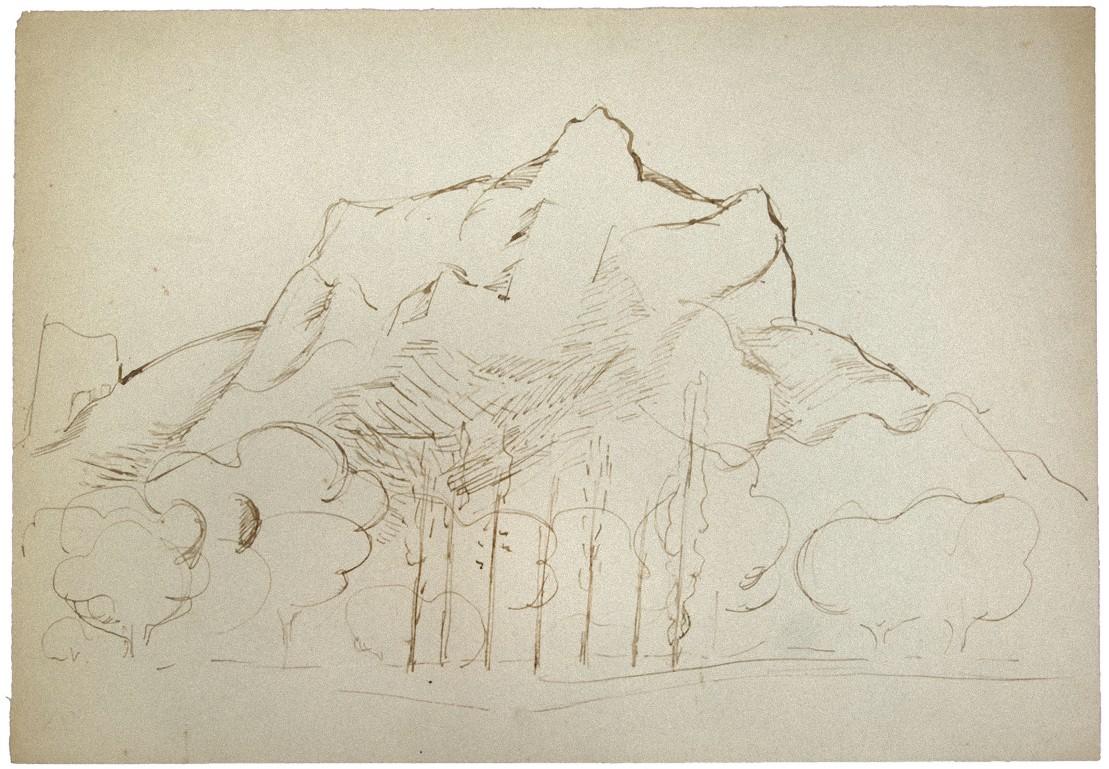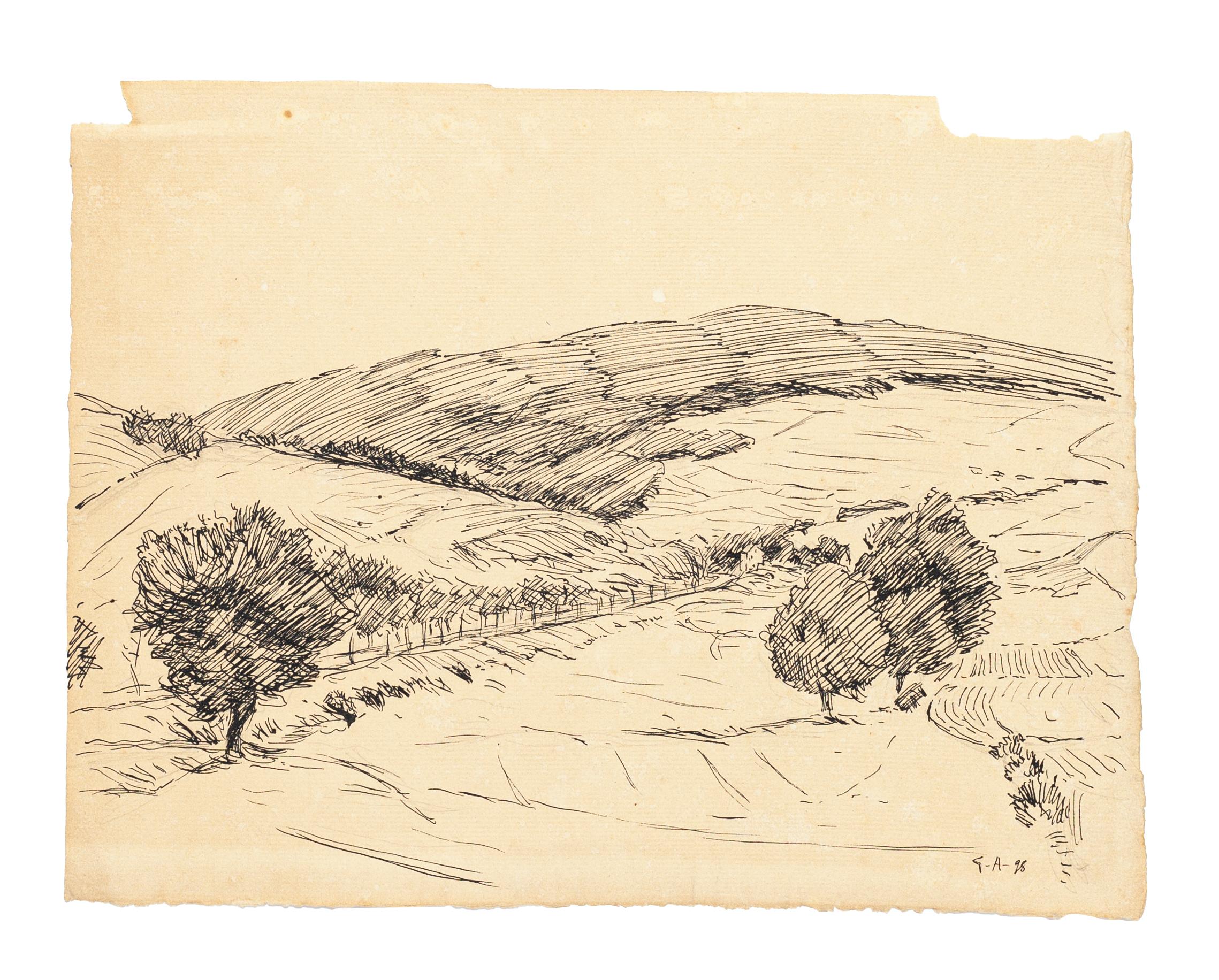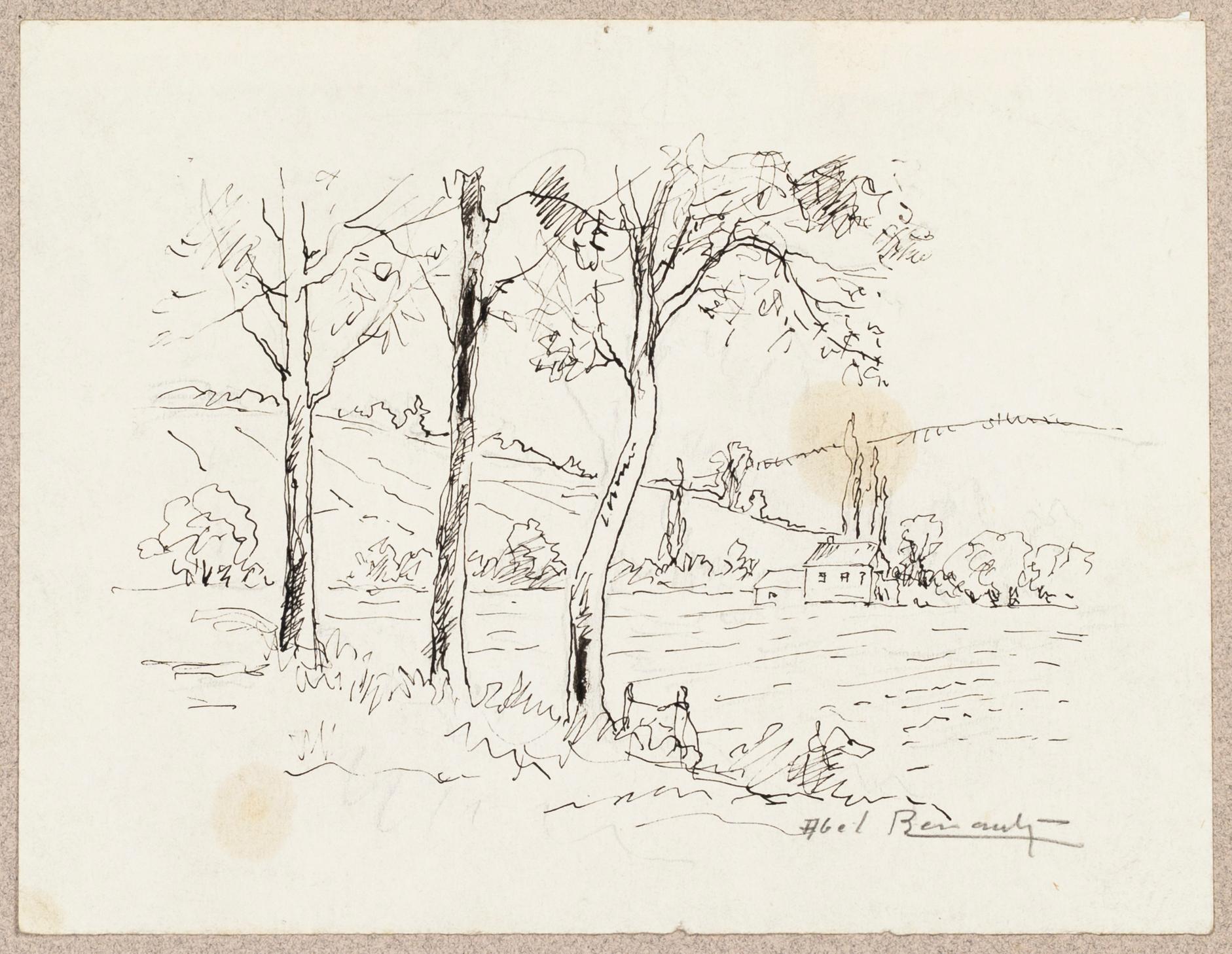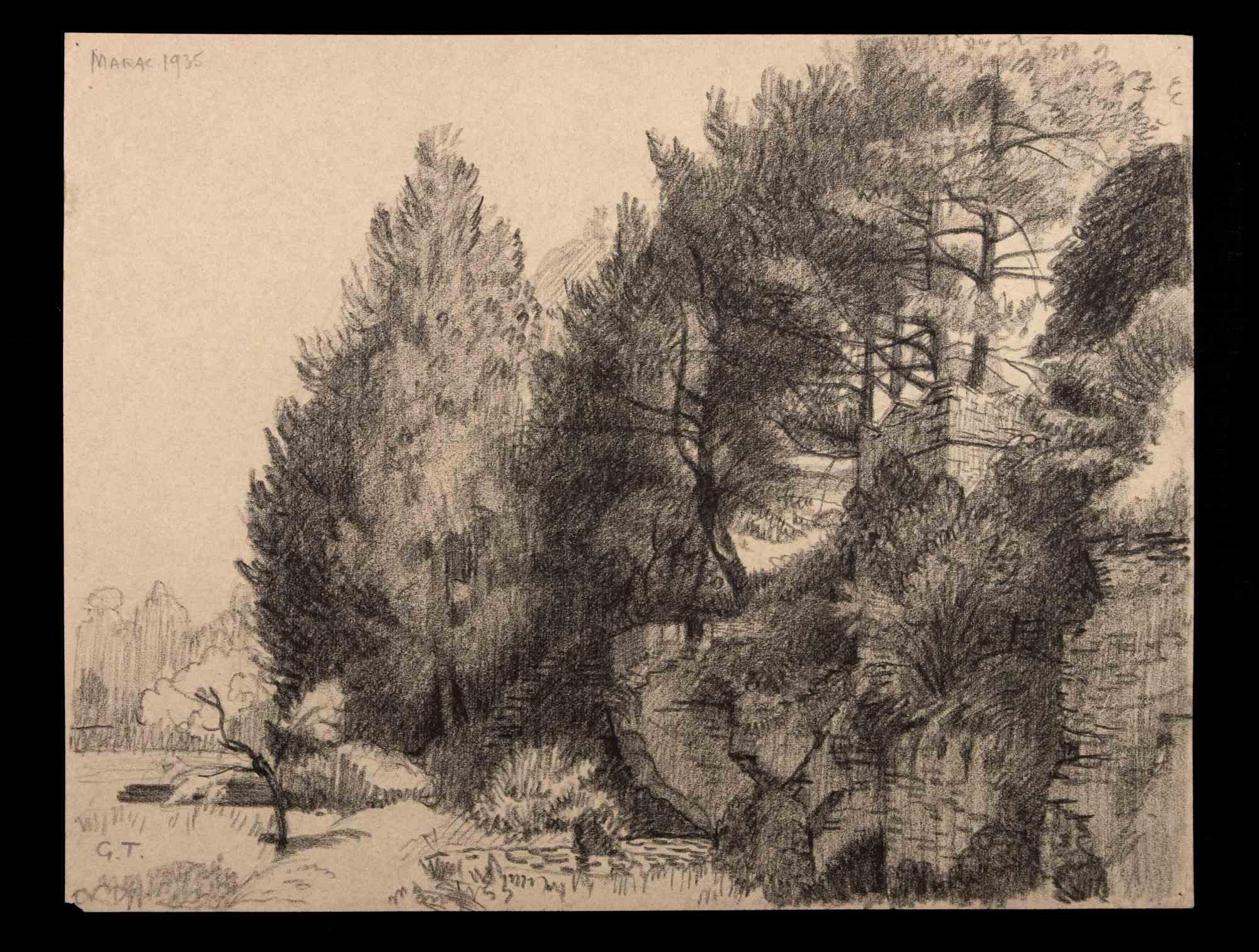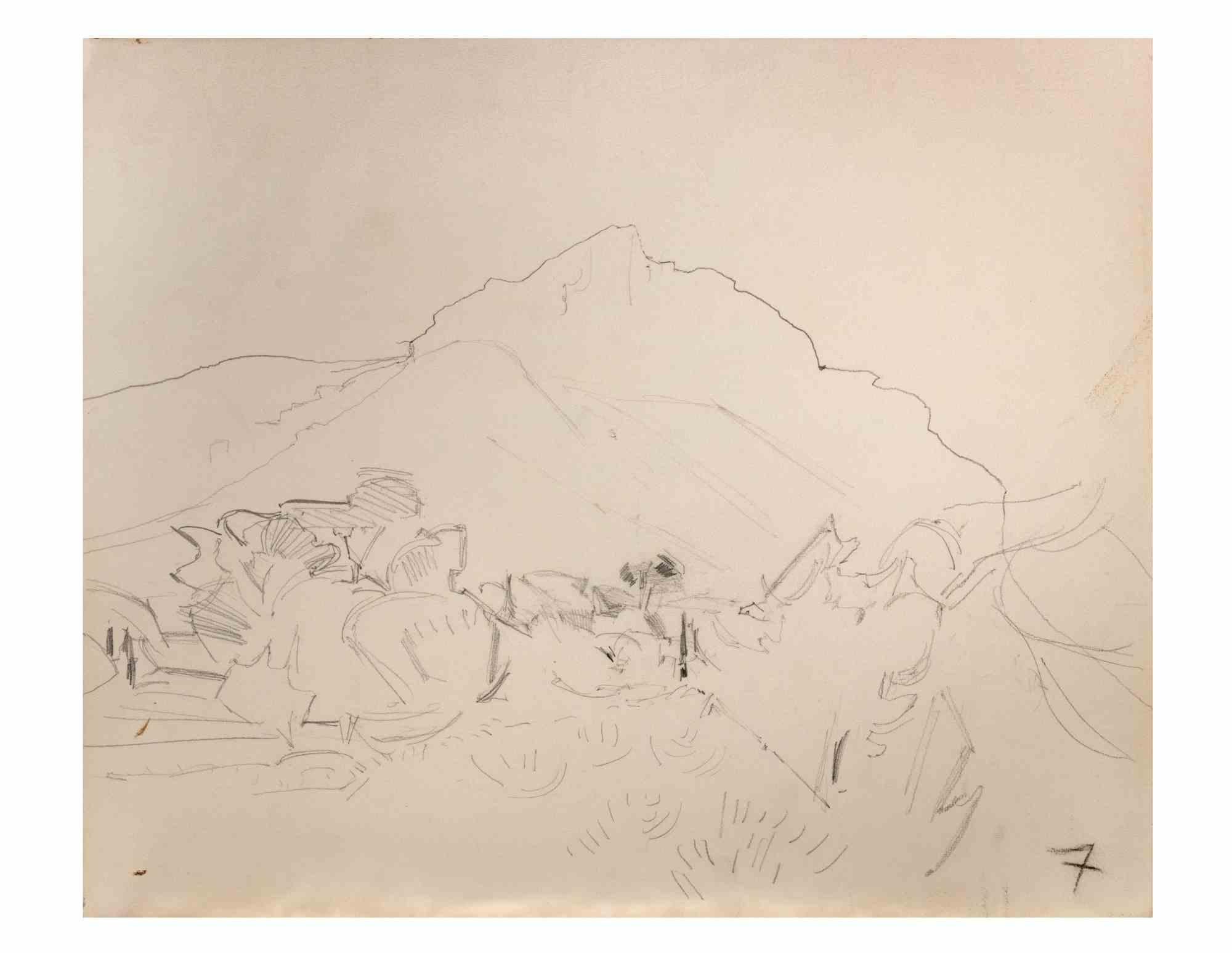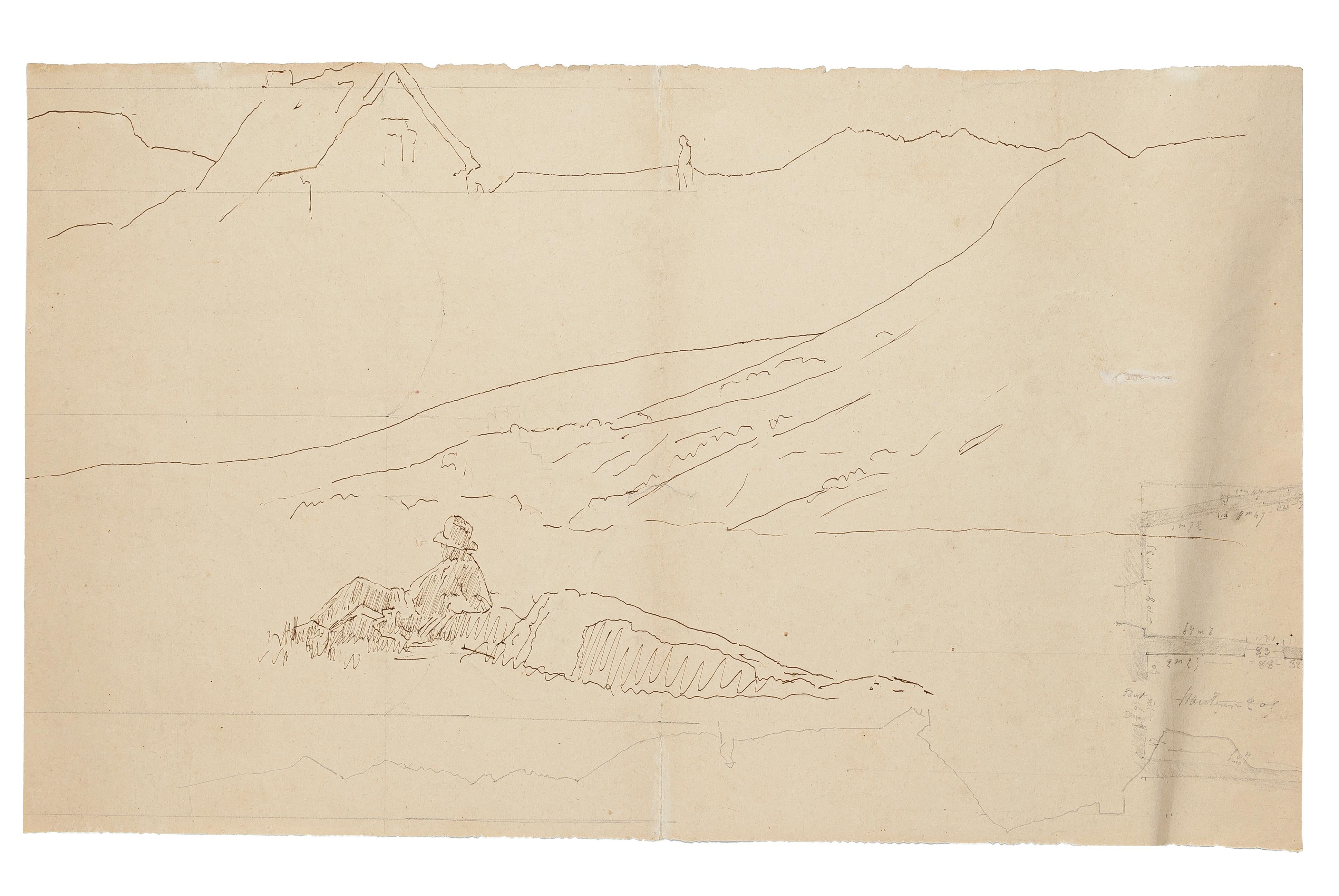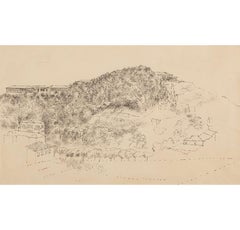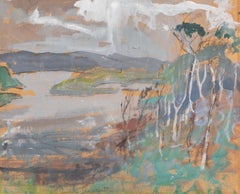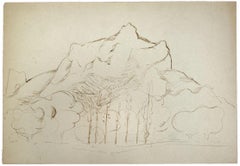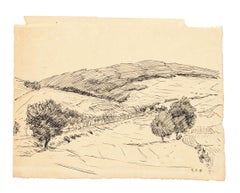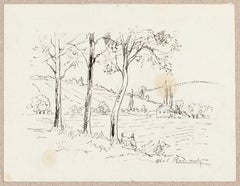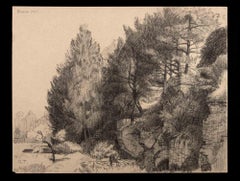Items Similar to Mountain Landscape, Pen and Ink Drawing by John Nash, 1950s, Double-sided
Want more images or videos?
Request additional images or videos from the seller
1 of 3
John NashMountain Landscape, Pen and Ink Drawing by John Nash, 1950s, Double-sidedcirca 1950
circa 1950
$6,840.63
£5,000
€5,882.60
CA$9,394.58
A$10,514.40
CHF 5,490.16
MX$128,276.24
NOK 69,690.32
SEK 66,131.82
DKK 43,928.50
Shipping
Retrieving quote...The 1stDibs Promise:
Authenticity Guarantee,
Money-Back Guarantee,
24-Hour Cancellation
About the Item
Mountain Landscape, Pen and Ink Painting by John Nash 1893-1977, circa 1950
Additional information:
Medium: Pen and ink, with another pen and ink with watercolour verso
29 x 21 cm
11 3/8 x 8 1/4 in
Signed
A large area of moorland located to the south of Peebles in the Scottish Borders, Ettrick Forest stretches from Dollar Law in the west to Selkirk in the east and rises steeply to the north of the Ettrick Water.
Provenance
Private Collection, UK
John Nash was a landscape and still life painter in oil and watercolour, a wood engraver and illustrator.
He was born in London in 1893. After some encouragement from his brother, Nash turned to watercolour landscapes and comic drawings having first worked as a journalist for a local newspaper. In 1913 he and his brother exhibited together at the Dorien Leigh Galleries, and his first solo exhibition was held at the Goupil Gallery in 1921. In 1913 he became a member of the Friday Club, of the London Group in 1914, the Cumberland Market in 1915, the N.E.A.C. and the Society for Wood Engravers in 1921 and the Modern English Water-Colour Society in 1923. He became an Associate member of the Royal academy in 1940, and a Member in 1951. He had begun to paint in oils in 1914, before serving with the Artists' Rifles during the First World War. In 1918 he was the Official War Artist. After the war he moved to Gerrards Cross where he lived until 1921. Whilst living here he became first art critic on the London Mercury. In 1922 he moved to Princes Risborough to teach at the Oxford Ruskin School where he remained until 1927. Nash then taught at the R.C.A. from 1934 to 1940, and again in 1945 until 1957. In 1937 he executed a large mural for the Paris Exhibition. During the Second World War he served in the Observer Corps, before becoming Official War Artist to the Admiralty in 1940. in 1944 he was demobilized and moved to Colchester, Essex, to live. During this time he exhibited with the Redfern Gallery. A retrospective exhibition of Nash's work was held in 1954 at the Leicester Galleries.
- Creator:John Nash (1893 - 1977, British)
- Creation Year:circa 1950
- Dimensions:Height: 11.38 in (28.91 cm)Width: 8.25 in (20.96 cm)
- Medium:
- Period:
- Condition:
- Gallery Location:Kingsclere, GB
- Reference Number:1stDibs: LU2718214575322
About the Seller
No Reviews Yet
Vetted Professional Seller
Every seller passes strict standards for authenticity and reliability
1stDibs seller since 2024
39 sales on 1stDibs
Typical response time: 18 hours
- ShippingRetrieving quote...Shipping from: Kingsclere, United Kingdom
- Return Policy
Authenticity Guarantee
In the unlikely event there’s an issue with an item’s authenticity, contact us within 1 year for a full refund. DetailsMoney-Back Guarantee
If your item is not as described, is damaged in transit, or does not arrive, contact us within 7 days for a full refund. Details24-Hour Cancellation
You have a 24-hour grace period in which to reconsider your purchase, with no questions asked.Vetted Professional Sellers
Our world-class sellers must adhere to strict standards for service and quality, maintaining the integrity of our listings.Price-Match Guarantee
If you find that a seller listed the same item for a lower price elsewhere, we’ll match it.Trusted Global Delivery
Our best-in-class carrier network provides specialized shipping options worldwide, including custom delivery.More From This Seller
View AllItalian Landscape, Pen Painting by Reginald Brill, 1950 circa
By Reginald Brill
Located in Kingsclere, GB
Italian Landscape, Pen Painting by Reginald Brill, 1950 circa
Additional information:
Medium: Ink
20 x 34 cm
7 7/8 x 13 3/8 in
Reginald " Reggie" Brill was a versastile 20th century artist and teacher.
Brill was born in London in 1902 and spent his early childhood there and in Yorkshire. By the time of the First World War, at the age of 13, he was living in lodgings in London, working in a City office and attending St Martins School of Art in the evenings. Considering his lack of education, winning a scholarship to The Slade (now part of University College London) in 1921 where he studied under Henry Tonks for three years, was a huge achievement.
On leaving The Slade he found patronage in Lincolnshire, but by the time of the General Strike (1926) he had returned to London and was working on Lansbury's Labour Weekly. He married Rosalie, also an artist, and in 1927 won the Prix de Rome in Decorative Painting. Following two years at The British School in Rome, Brill went to teach at Blackheath School of Art. During 1930 he spent three months painting in Egypt and it was there that he met Col. T G Gayer-Anderson, one of the twin brothers who were to bequeath The Little Hall in Lavenham as a hostel for art students. It was there that Brill retired to act as warden, thus continuing his nurturing of art students until his death in 1972.
Brill took up his appointment at The School of Art, Kingston upon Thames in January 1934. It was situated in the Technical Institute (Kingston Hall Road) and Brill found it bohemian and disorganised. He proceeded to inject enthusiasm, order and discipline. Within 5 years of his appointment a purpose-built School of Art was opened in Knights Park. It remained open throughout the war and by 1945 there was a waiting list for places. Under the skilled and totally dedicated direction of Brill, Kingston School of Art became established with national reputation for excellence. In 1961 Sir Charles Wheeler opened the new building at Knights Park. Costing £100,000, this more than doubled the size of the Art School.
Brill, was a well-known figure in Kingston. His eloquence made him popular as a guest speaker and his promotion of Art and Design stretched well beyond the doors of Knights Park. Apart from establishing two of the main buildings which makeup what is now known as the Faculty of Design, one of the most visible local contributions he made was the setting up of a topographical collection of paintings depicting Kingston, which has since become known as The Brill Collection at Kingston Museum. Brill gained huge respect and admiration from the hundreds of pupils who studied at Kingston during his 30-year leadership.
He published two books, Modern Painting 1946 and Art as a Career 1962, both bearing a strong educational angle. He regularly exhibited along with leading artists of his era at The Royal Academy, both his paintings and his acutely observed drawings. All the while he was a prolific artist, although reading his diaries, intensely self-critical. His perfectionism, acute powers of observation and relentless research can be seen in his drawings, which via the media and methods he explored throughout his life reflect mid 20th century British Art at its most typical. His major series of work, known as 'The Martyrdom of Man', was carried on in parallel to his career as a teacher. These paintings reflect his care for fellow man and depict people at work, e.g., The Operation, The Jury, Linemen, Waiting Room and Rest, which recently sold at Sotheby’s and was specially restored for The Brill Retrospective. His smaller works also play with the theme of everyday events and communication amongst people, such as The Bull Ring and Market Place paintings.
Brill's name is associated particularly with human figure compositions, but he also worked on landscapes, portraits and details of plants, animals, interiors etc. As one would expect he moved from one media to another, and his unusual hand painted and cut paper mosaics...
Category
20th Century Landscape Paintings
Materials
Pen
Italian Scene, Pen and Ink with Wash Painting by Reginald Brill, 1950s circa
By Reginald Brill
Located in Kingsclere, GB
Italian Scene, Pen and Ink with Wash Painting by Reginald Brill, 1950s circa
Additional information:
Medium: Pen and ink with wash
33 x 48.3 cm
13 x 19 in
Reginald " Reggie" Brill was a versastile 20th century artist and teacher.
Brill was born in London in 1902 and spent his early childhood there and in Yorkshire. By the time of the First World War, at the age of 13, he was living in lodgings in London, working in a City office and attending St Martins School of Art in the evenings. Considering his lack of education, winning a scholarship to The Slade (now part of University College London) in 1921 where he studied under Henry Tonks for three years, was a huge achievement.
On leaving The Slade he found patronage in Lincolnshire, but by the time of the General Strike (1926) he had returned to London and was working on Lansbury's Labour Weekly. He married Rosalie, also an artist, and in 1927 won the Prix de Rome in Decorative Painting. Following two years at The British School in Rome, Brill went to teach at Blackheath School of Art. During 1930 he spent three months painting in Egypt and it was there that he met Col. T G Gayer-Anderson, one of the twin brothers who were to bequeath The Little Hall in Lavenham as a hostel for art students. It was there that Brill retired to act as warden, thus continuing his nurturing of art students until his death in 1972.
Brill took up his appointment at The School of Art, Kingston upon Thames in January 1934. It was situated in the Technical Institute (Kingston Hall Road) and Brill found it bohemian and disorganised. He proceeded to inject enthusiasm, order and discipline. Within 5 years of his appointment a purpose-built School of Art was opened in Knights Park. It remained open throughout the war and by 1945 there was a waiting list for places. Under the skilled and totally dedicated direction of Brill, Kingston School of Art became established with national reputation for excellence. In 1961 Sir Charles Wheeler opened the new building at Knights Park. Costing £100,000, this more than doubled the size of the Art School.
Brill, was a well-known figure in Kingston. His eloquence made him popular as a guest speaker and his promotion of Art and Design stretched well beyond the doors of Knights Park. Apart from establishing two of the main buildings which makeup what is now known as the Faculty of Design, one of the most visible local contributions he made was the setting up of a topographical collection of paintings depicting Kingston, which has since become known as The Brill Collection at Kingston Museum. Brill gained huge respect and admiration from the hundreds of pupils who studied at Kingston during his 30-year leadership.
He published two books, Modern Painting 1946 and Art as a Career 1962, both bearing a strong educational angle. He regularly exhibited along with leading artists of his era at The Royal Academy, both his paintings and his acutely observed drawings. All the while he was a prolific artist, although reading his diaries, intensely self-critical. His perfectionism, acute powers of observation and relentless research can be seen in his drawings, which via the media and methods he explored throughout his life reflect mid 20th century British Art at its most typical. His major series of work, known as 'The Martyrdom of Man', was carried on in parallel to his career as a teacher. These paintings reflect his care for fellow man and depict people at work, e.g., The Operation, The Jury, Linemen, Waiting Room and Rest, which recently sold at Sotheby’s and was specially restored for The Brill Retrospective. His smaller works also play with the theme of everyday events and communication amongst people, such as The Bull Ring and Market Place paintings.
Brill's name is associated particularly with human figure compositions, but he also worked on landscapes, portraits and details of plants, animals, interiors etc. As one would expect he moved from one media to another, and his unusual hand painted and cut paper mosaics...
Category
20th Century Landscape Paintings
Materials
Pen
Pastoral Landscape, Gouache and Watercolour Painting by Alan Reynolds, 1953
By Alan Reynolds
Located in Kingsclere, GB
Pastoral Landscape, Gouache and Watercolour Painting by Alan Reynolds, 1953
Additional information:
Medium: Gouache and watercolour
19.5 x 27.5 cm
7 5/8...
Category
20th Century Abstract Drawings and Watercolors
Materials
Gouache
Borders Landscape, 1930s - Framed Landscape Painting with Mountains, Trees, Lake
Located in Kingsclere, GB
Borders Landscape, Gouache on Buff Paper Painting by Anne Redpath , 1934 circa
Additional information:
Medium: Gouache on buff paper
43 x 53.5 cm
16 7/8 x 21 1/8 in
Signed
Redpath'...
Category
20th Century Modern Landscape Paintings
Materials
Gouache, Paper
Foot of Pistyll Rhaeadr, Ink and Wash Painting by John Piper, circa 1939-1941
By John Piper
Located in Kingsclere, GB
Foot of Pistyll Rhaeadr, Ink and Wash Painting by John Piper, circa 1939-1941
Additional information:
Medium: Ink and wash
12.5 x 17.7 cm
4 7/8 x 7 in
Titled under the mount
John Piper was a painter of architecture, landscape and abstract compositions, a designer for the theatre and of stained-glass windows, and a writer on the arts.
Piper was born in 1903 in Epsom, Surrey, the son of a solicitor. Throughout his childhood, he regularly visited Italy, and by 1924 he had published a book of poems and his own illustrations. He worked in his father's office in Westminster until 1928 when he began studying at the Richmond and Kingston Schools of Art. This was followed by two years study at the Royal College of Art. In 1927 he exhibited with David Birch at the Arlington gallery, and in 1931 with Clarice Moffat, P. F. Millard, and his first wife Eileen Holding...
Category
20th Century Abstract Paintings
Materials
Ink
Landscape with Trees, Pencil Drawing by Michael Andrews
Located in Kingsclere, GB
Landscape with Trees, Pencil Drawing by Michael Andrews
Additional information:
Medium: Pencil drawing
12.5 x 19.5 cm
4 7/8 x 7 5/8 in
Michael Andrews was born into a devout Method...
Category
20th Century Landscape Drawings and Watercolors
Materials
Pencil
You May Also Like
Landscape - Drawing in Pen by Herta Hausmann - 1950
Located in Roma, IT
Landscape is a drawing in pen realized by H. Hausmann around 1950.
Stamped on the rear.
Good conditions but aged and a small cutaway on the top-right angle.
This interesting drawi...
Category
1950s Modern Landscape Drawings and Watercolors
Materials
Pen
Landscape - Original Pen Drawing - Mid 20th Century
Located in Roma, IT
Landscape is an original drawing in pen on paper realized by an Anonymous artist of the 20th century. With monogram of the artist on the lower right in pen.
The State of preservatio...
Category
1950s Figurative Drawings and Watercolors
Materials
Pen
Paysage - Original China Ink Drawing by Abel Pierre Renault - Mid 1900
Located in Roma, IT
Image dimensions: 20.2 x 17 cm.
Paysage is a beautiful original black China ink drawing on paper, realized by the French artist Abel Pierre Renaut (1903-1992).
Signed in pencil on...
Category
Mid-20th Century Landscape Prints
Materials
Ink
Landscape with Trees - Original Drawing by George-Henri Tribout - 1940
By Georges-Henri Tribout
Located in Roma, IT
Landscape with Trees is an original artwork realized by Georges Henri Tribout in 1935 in Marac. Pencil Drawing, hand signed on the lower margin left and dated "Marac 1935" on the lef...
Category
1940s Modern Landscape Drawings and Watercolors
Materials
Paper, Pencil
Landscape - Drawing By Reynold Arnould - Mid-20th Century
Located in Roma, IT
Landscape is a pencil drawing realized by Reynold Arnould (Le Havre 1919 - Parigi 1980).
Good condition on a yellowed paper, no signature.
Reynold Arnould was born in Le Havre, Fr...
Category
Mid-20th Century Modern Landscape Drawings and Watercolors
Materials
Pencil
Landscape - Original Pen Drawing - Mid 20th Century
Located in Roma, IT
Landscape is an original drawing in pen on paper realized by an Anonymous artist of the XX century.
In good condition with a small stain on the edge and small tearing on the margin ...
Category
1950s Figurative Drawings and Watercolors
Materials
Pen
More Ways To Browse
John Cross
The Redfern Gallery London
Cross Scotland
John Nash
Used Rifles
Vintage Cross Pens
J L George
Loch Painting
Oil Painting Lewis
Oil Paintings Of Sailor
1910s Oil Painting
Golden Gate Painting
Impressionist Sunflower
Outdoor Island
Pink Mountain Landscape
Wine Paintings France
Barbara Flowers
English Boat Paintings
